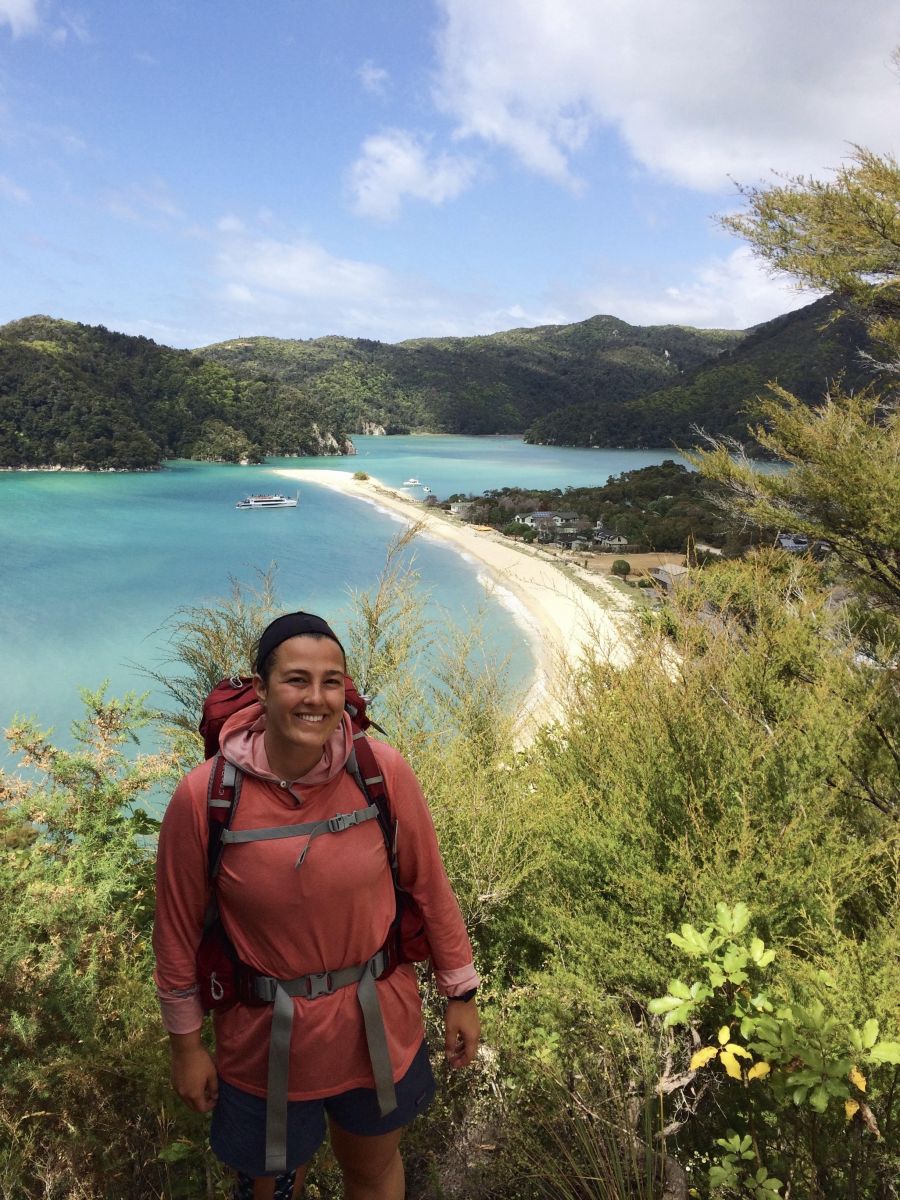Off-the-Grid with Diabetes: Hiking and Backpacking in the Wilderness
 By Justine Szafran
By Justine Szafran
Outdoor adventures take extra planning for people with diabetes. Justine shares tips for packing supplies, keeping insulin cold, staying hydrated, and managing blood sugar levels during active, multi-day trips in the wilderness
Spending a day or more outdoors – especially out in the wilderness – can pose unique challenges for people living with diabetes. How do you keep medication cold? How will blood glucose levels respond to new variables? How can you manage full day hikes? What extra supplies might you need? While these questions may feel overwhelming, people with diabetes do explore the outdoors and do go on long (and successful!) outdoor adventures.
A little over a year ago, I was fortunate enough to travel remotely around the South Pacific on a study abroad program through Carleton College. The program went to the island of Rarotonga in the Cook Islands, to various national parks, and to remote places in New Zealand and Australia. I’ve had type 1 diabetes for almost 12 years, and while I’ve done a fair amount of outdoor adventuring before, preparing for this trip had its unique challenges. The program involved a lot of hiking and temperatures typically ranged from 70 – 110 degrees Fahrenheit as we moved around the region. In order to have a successful trip, I had to plan for being in different country, spending long periods of time in remote wilderness areas, and having exposure to high temperatures. After finishing this program, I feel very capable traveling to new and remote locations while successfully managing my diabetes. And you can too!
Packing supplies for the wilderness
One of the highlights of the three-month program was a week I spent backpacking with a few friends in New Zealand’s Abel Tasman National Park. Hiking outdoors for long periods of time involves a lot of backup medical supplies and attention to detail. For multi-day trips, I like to carry at least double the amount of supplies I would normally need in order to put my mind at ease. I prepare for any and all situations that may put my health at risk or interfere with my diabetes management. I use an OmniPod insulin pump to help manage my blood glucose, so for me, this included packing: double pump infusion sets and Dexcom G6 continuous glucose monitor (CGM) sensors, an extra CGM transmitter, backup batteries for my pump and blood glucose meter, and an external battery for my phone (which is how I view my blood sugar readings). I also brought enough blood glucose test strips and syringes to last if my CGM or pump were to fail, and two blood testing kits. Carrying these supplies meant I had less room for other things, so I packed very lightly otherwise and carried less of our shared food.
Not all of the places we visited involved multi-day backpacking, though. When heading out for a day hike I usually only need to bring along one spare of most items. I carry a vial of insulin, a pump set change, and a blood testing kit (in case my CGM fails).
Keeping insulin cool during hot hikes
Because I’d be outdoors for so long in the summer heat, keeping my insulin cool was my biggest concern. I carried almost triple the amount of insulin I would normally use in Frio cooling cases. These packs are incredible – you just soak them in water every two to three days and they can keep insulin cool even in very hot temperatures. When I was backpacking, I kept my Frio packs near the top layer of my bag. Keeping them under a layer of clothes helped to protect them from the hot sun hitting the outside of my bag. They need some air to function properly, so ensuring that they weren’t in a totally airtight location was also important. I opened my bag every few hours to check on them, feeling that the inside of the packs was still cool just to be safe.
Calculating insulin doses, staying hydrated, and managing blood glucose levels
On a typical morning of a long hike, I used a lot of “lead time” with my breakfast insulin dose. I tried to allow half an hour to an hour of time between dosing and eating. This helped me avoid a drastic blood sugar spike after I ate my relatively high-carb breakfast of oats, banana, and peanut butter. However, when I know I’m going to be active all day, my breakfast dose can be much lower than usual. I typically only gave myself 50-70% of the insulin that is recommended by my pump presets.
I also drank a full 32 ounces of water first thing when I woke up. Along with packing up our campsite and some stretching, this was a good way to fill the time between my morning insulin dose and breakfast. Dehydration can actually cause blood sugar levels to rise, so staying as hydrated as possible throughout the day was crucial for feeling my best in such hot temperatures and keeping my blood sugar numbers in range. On especially hot days I dissolved a Nuun tablet in my water bottle (2g carbs each) to add some electrolytes, without drinking too much extra sugar.
When you are hiking for many hours at a time, you generally need less insulin. This is because exercise makes you more insulin sensitive. Because I was using an insulin pump, temp basal settings were helpful for managing this. If I saw my CGM numbers dropping below my ideal range, I’d start a basal decrease of 50-100% for an hour at a time depending on what was happening, and continue to monitor the trend. Keeping nuts and dried fruit easily accessible was also a good way to correct falling levels if the temp basal wasn’t acting quickly enough. My friends and I stopped every few hours to snack on things like hummus, carrots, and multigrain crackers. If I had a more severe low blood sugar, I ate two cubes of Clif Shot Bloks (16g of carbs). I liked using these because they work extremely quickly, the packaging is compact, and they are available in many good flavors.
A few more safety measures
Overnight, I kept my phone in my sleeping bag. This let me feel any CGM vibration alerts and also keep my phone warm, helping to preserve the battery as temperatures dropped to as low as 40 degrees. I kept a package of Shot Bloks nearby and easy to find in case my blood sugar dropped unexpectedly in the middle of the night. I also kept my phone on airplane mode to maximize phone battery life during the trip so I could continue receiving CGM alerts. I definitely took lots of photos, but I made sure all other apps other than Dexcom weren’t running in the background.
While I feel very comfortable managing my type one diabetes alone, it was important that the people backpacking with me understood the basics of diabetes and what to do in the event of an emergency low blood sugar. Before we left, I showed my friends how to use my glucagon kit and where I keep it in my pack. I answered any questions they had and assured them that this scenario was unlikely. I also told them we might need to take short breaks during the day if my blood sugar was severely out of range, but that I didn’t expect anything too out of the ordinary to happen.
Although taking on outdoor adventuring with diabetes can feel daunting, it is actually very doable and rewarding. I came away from this program feeling a renewed confidence in my ability to take care of myself anywhere life might lead me. With the right tools and planning, anyone with diabetes can feel just as assured in their ability to manage blood sugar levels in the wilderness as they do in everyday life. If you have diabetes, don’t let anyone tell you that traveling remotely outdoors isn’t possible! By working with your diabetes care team, you can create a comprehensive plan to travel outdoors while having an incredibly fun and safe experience, too.
This article is part of a series on time in range.
The diaTribe Foundation, in concert with the Time in Range Coalition, is committed to helping people with diabetes and their caregivers understand time in range to maximize patients' health. Learn more about the Time in Range Coalition here.
 About Justine
About Justine
Justine loves spending time outdoors and making art. She graduated from Carleton College in 2019, with a double major in Political Science and Studio Art. Justine currrently works at Carleton College as an Educational Associate in Studio Art, specializing in drawing, printmaking, and ceramics. She enjoys rock climbing, cycling, teaching kids how to sail, and writing.
Justine has been living with type one diabetes for twelve years and is always looking for new ways to make life with type one easier to manage.







